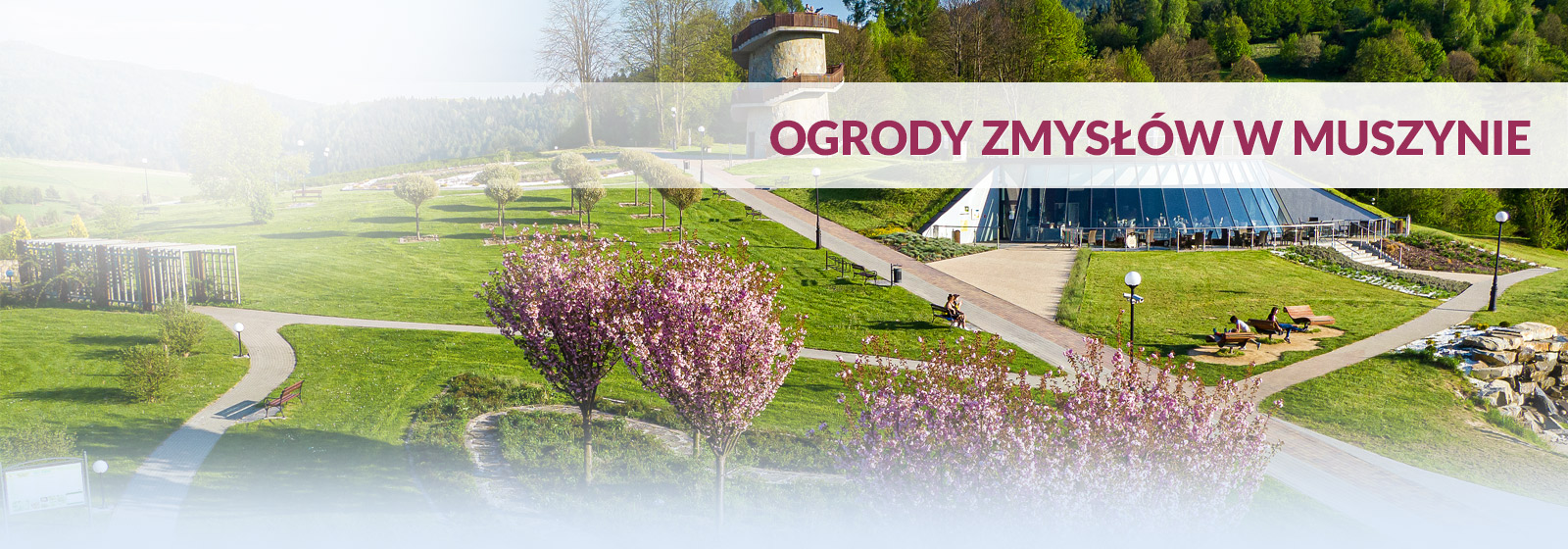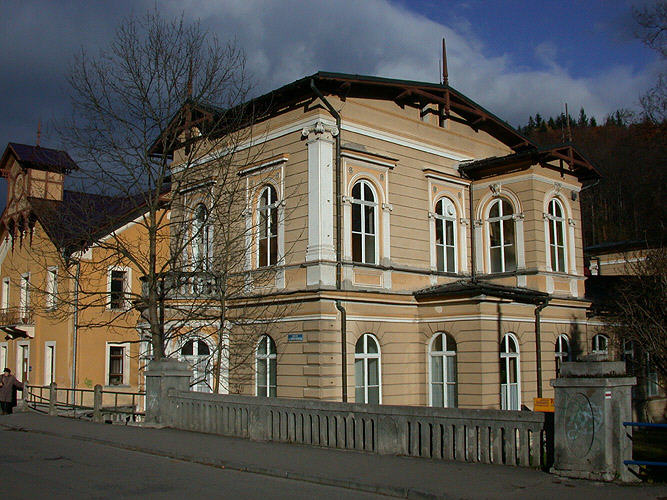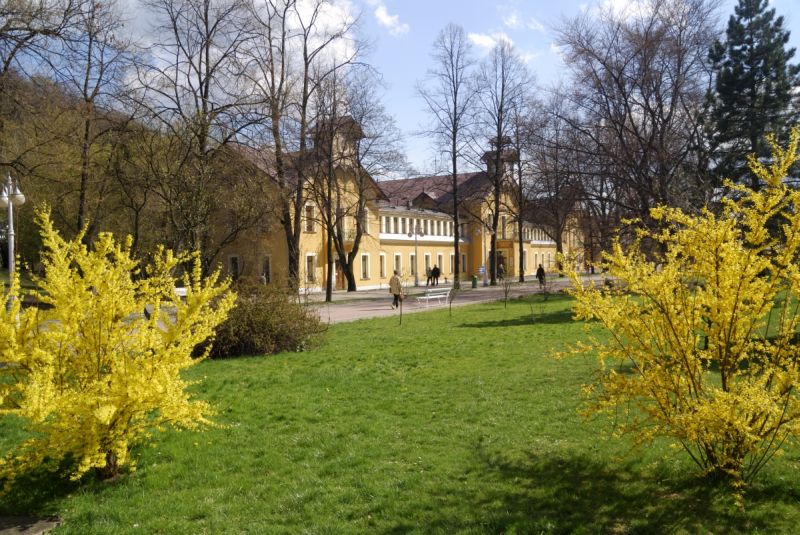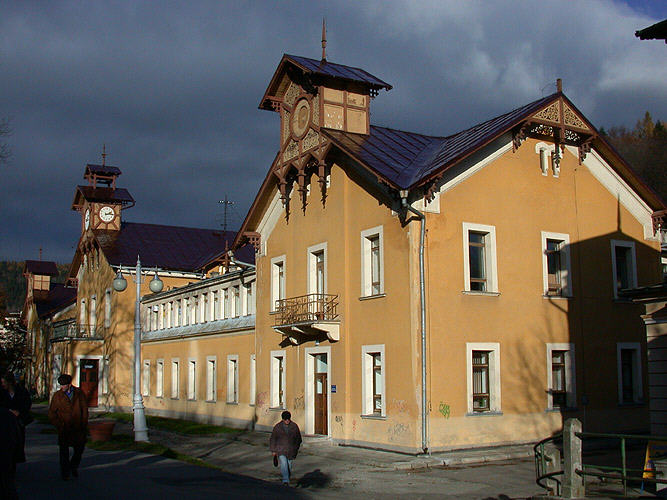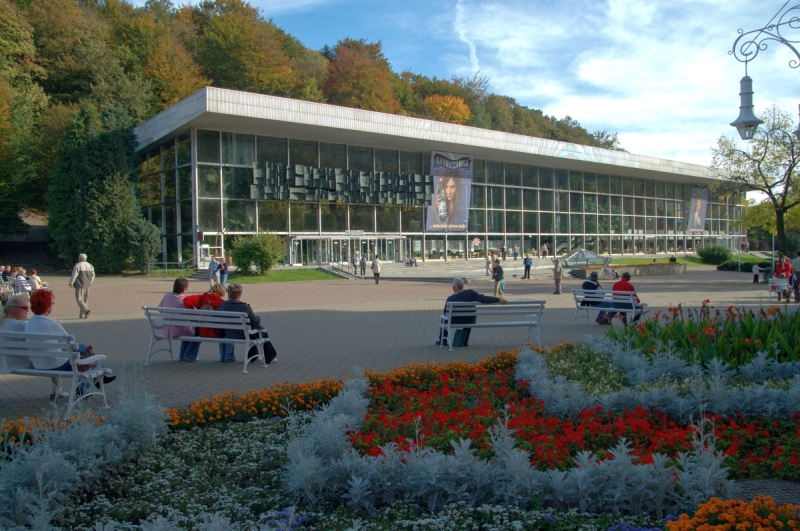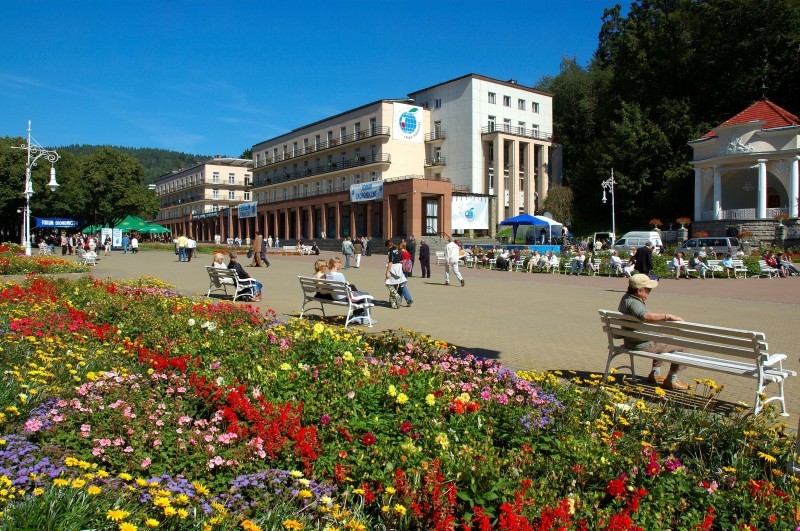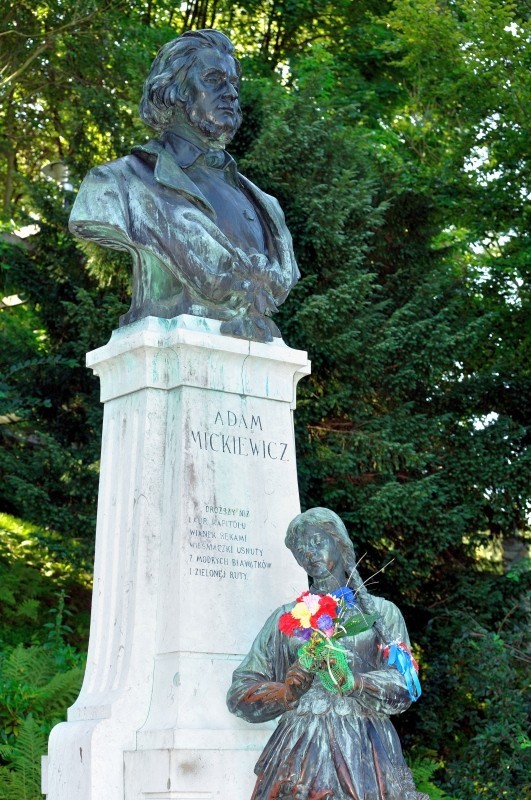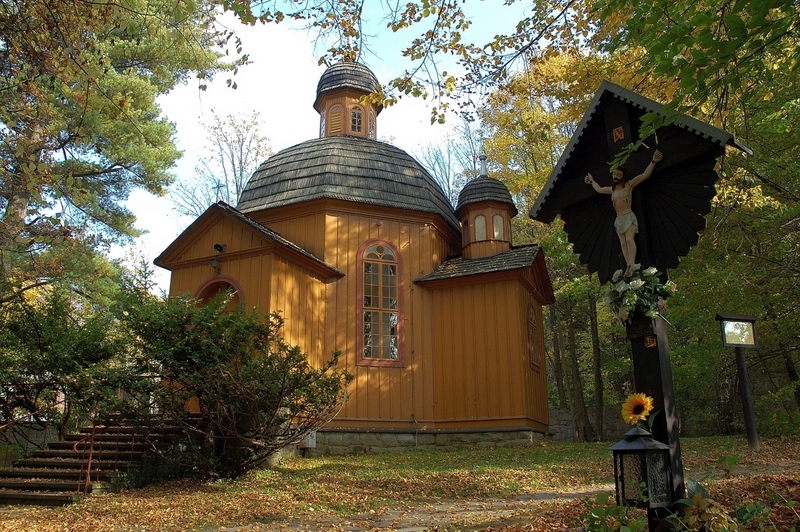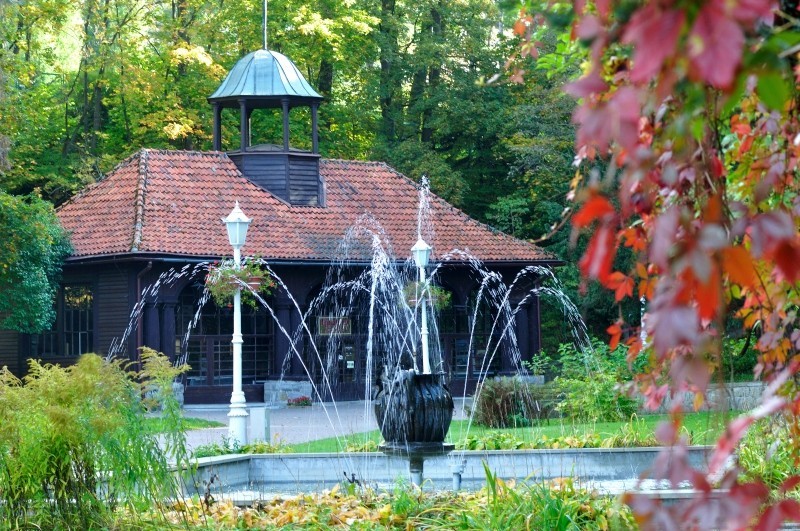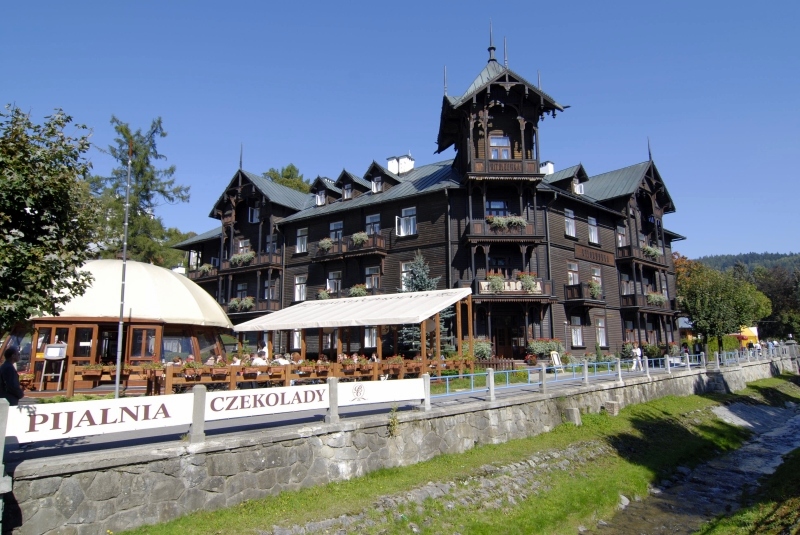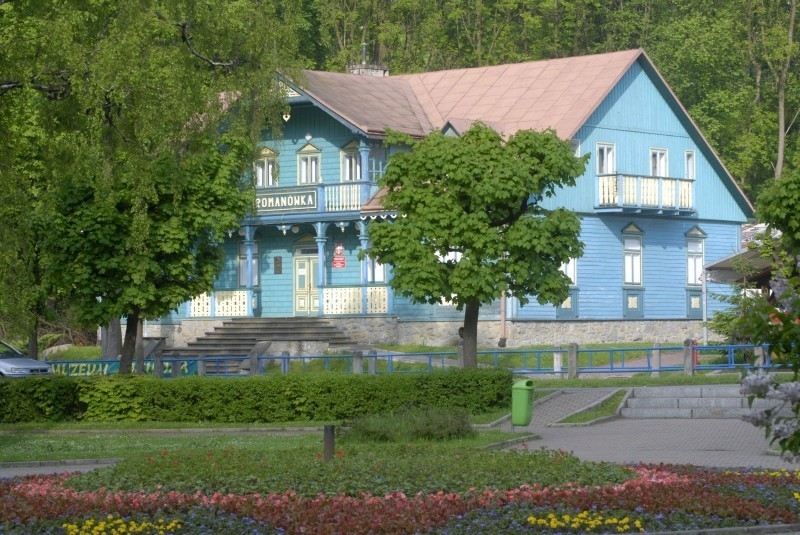Bathrooms mud. This brick building was erected in 1881 in the eclectic architectural style. In the first years of its existence, the bathrooms were directed by Dr. Henry Ebers
Old Bathrooms, formerly called ‘mineral’, were built between 1863-1864 on the initiative of Professor Joseph Dietl. Designed by Felix Księżarski, one of the Krakow's most famous architects and the designer of the Jagiellonian University’s Collegium Novum, theBathrooms are one of the oldest and most characteristic buildings in Krynica. Initially they were one of the most modern of its kind in Europe.
The wooden, plastered building has side projections and decorative architectural details. Inside, there are 72 rooms with 82 baths, six mud cabins and two shower and steam cabins. The 17 rooms on the first floor, once used for lodgings, presently house a hairdresser salon, a solarium, a massage studio and a medical analytical laboratory.
The Pump Room Complex is a spacious, modern building of aluminium, glass and steel construction. It was built to replace the former Old Pump Room, which was almost a 100 year old, with an indoor promenade. The small remaining part of the original old building is covered with glass. The Main Spring is located in front of the new building. The ceremonial opening of the building took place on July 19, 1971. The majority of Krynica’s wells were moved to the building – today, beside the Main Spring you can also taste the "Zuber," "John", "Tadeusz" and "Slotwinka Springs. On the slope inside the building there is a small conservatory where you can admire beautiful specimens of palm trees, date palms, rare shrubs and ornamental plants. The Pump Room has a concert hall with 350 seats, where the Orchestra Zdrojowa gives concerts throughout the whole year. At the entrance to the hall, there is a plaque commemorating Rudolf Zuber, Krynica’s researcher and discoverer of ssprings. The plaque was unveiled in 1981. There is also a permanent exhibition of Krynica’s Photographic Society. The Pump Room hoses many trade fairs, congresses, exhibitions and concerts during the Jan Kiepura’s festival. The Pump Room is open daily from 6:30 to 18:00
Old Spa House. The house is situated in the central part of the pedestrian zone opposite the Main Fountain. The building, designed by Julian Niedziejski and Jan Zawiejski, was erected in 1889 in Neo-Renaissance style and originally called “The Spa”. Previously, in the years 1810-1889, the home "At the Lamb", a place of social meetings, theatre performances and concerts was situated here. The present building houses a spa, a restaurant, a stylish, beautifully decorated ballroom, where concerts, balls, recitals and banquets are organized. The northern wing is a pump room of the mineral water fountain "Mieczyslaw" (open from 10:00 to 18:00). Due to its beautiful décor and central location, the Old Spa House was a favourite holiday site for many Polish personages, including Wladyslaw Reymont, Leon Wyczolkowski, Jadwiga Smosarska and Jozef Pilsudski. A plaque to his memory, commemorating the 10th anniversary of the successful counterattack against the Soviet Army in 1920, which was sponsored by the local community, is placed on the southern wall of the building. The plaque, destroyed in the later years by the Communists, was unveiled again on August 15 1990.
The Concert shell. Located between the main Pump Room and the New Spa House, the shell was built in the interwar years, on the original site of old orchestral pavilion from 1870. In the summer, it is a place of the Spa Orchestra concerts. It continues a long-hold tradition of concerts for the entertainment of the spa patients which started in the mid-nineteenth century. At the front of the shell, a plaque commemorating Jan Kiepura is placed.
The New Home Spa. The building, located on the left side of the concert shell, was built in 1939 according to the design of Witold Minkiewicz (who was also the designer of University of Lviv and Gdansk buildings). Previously, it housed the boarding house "Under the Black Eagle" and a pharmacy ‘Under an Angel’.
On the first and second floor there is a sanatorium, and the ground floor is occupied by a stylish penthouse, a dining room and a shop area. In the summer, on the steps of the New Spa House, the local sculptors, painters, and authors present their works.
Adam Mickiewicz's Monument is located at the intersection of the pedestrian zone and the Dietl Boulevard, on the slope of Parkowa Mountain. The idea of erecting the monument came in August 1883 from Edward Odyniec, the last living Mickiewicz friend who stayed here at that time. The monument was designed by Cracowian sculptor Antoni Popiel and unveiled on August 12, 1906.
The Church of Transfiguration is located in the park, near the beginning of the Dietl Boulevard. It is the oldest church, called also “The Park Church". The designer of the wooden church built in 1862 was Felix Księżarski. Its architecture is an interesting example of the architectural style of church buildings typical for this area. It is a log timber construction with a cross layout and a shingled roof. The two altars in the interior dating from the late 19th and the early 20th century, respectively, depict the Transfiguration Scene and the painting of ‘Our Lady of Częstochowa’. A wooden cross placed near the church in 1910 commemorates the Great Battle of Grunwald. Masses are celebrated here on Saturdays (summer months) at 10:00; indulgence on the feast of the Transfiguration, August 6th.
The Pump Room ‘John’ in the Nikifor Krynicki Alley is located 300 meters from the Dietl Boulevard, behind the bridge over the Palenica Stream, on the so-called “Janówka “. In the 1880s it consisted of two wooden pavilions housing the springs "Joseph" and "John." In 1923, they were combined into the presently existing form. The building, topped by a hipped roof with a cupola and illuminated by stylish lamps, is located in the park. The spring "Joseph was initially called “Dudzik”, after the name of the owner. In 1880, after its purchase by the Spa Board, its name was changed in honor of Dr. Joseph Merunowicz (who at that time was the head of the Department of Sanitary Governorship in Lviv) who contributed much to the development of the Krynica health resort. The second spring is called after the former bathing attendant named John, who used to bring its initially untapped water to the spa patients taking therapeutic mud treatments. Opening hours: 10:00-14.00, and14:30 - 18.00 (beyond the holiday season from 10:00 - 13.00).
The Monument of Dr. Jozef Dietl "To the Man who revived us – from the grateful Krynica Citizens” is - located at the crossing point of the Dietl Boulevard, the Zdrojowa, the Pułaski and the Piłsudski Streets, in the small park commemorated to Dr. Mieczyslaw Dukiet, a person of merit for Krynica (previously, the Dietl Park).
The monument, designed by Leon Zawiejski, was unveiled during the Congress of Medicine in 1900. y
.
A large fountain named “Setka”, beautifully illuminated in the evenings, is placed nearby
Nikifor Krynicki Monument. The monument, placed at the promenade entrance, is a bronze figure of the Krynica’s famous naive painter. The figure which measures over two meters and weighs about 900 kg was originally intended for the Pulaski street, where Nikifor was most often to meet. The monument, designed by prof. Czeslaw Dźwigała, was unveiled on September 9th 2005 to commemorate the 110 birthday of the painter. The ceremonial unvailing was carried out by the Polish president Aleksander Kwasniewski, attended by the president of Lithuania Valdas Adamkus, visiting the 15th Economic Forum in Krynica. Nikifor was a very colorful character; he moved his portable “studio” each day to a different location in the town, so that all residents and patients knew him by sight. The painter is therefore shown sitting on a street bench, with a brush in hand and in the company of a stray dog (symbolizing his own life situation as a homeless person with no ethnic affiliation). A plaque with Polish and Lemko inscription is placed on the monument.
Dietl’s Boulevard parallels the promenade, stretching along the Kryniczanka Stream. Here are located the oldest historic houses and pensions: next to the Old Spa House stands "Romanówka", dating from the second half of the 19th century (presently housing the Museum of Nikifor Paintings), "Węgierska Korona” (“The Hungarian Crown”) built in 1880 in the pseudo-Swiss style (nowadays housing a pizzeria and a cafe),"Switeź "(built in 1880), "Kosynier (built in 1880, since 1959 the seat of the Nowy Sacz Branch of the National Music School), "Małopolanka" (with its interior decor in the 1920s style), "Villa Białej Róży" (“The White Rose Mansion”) built in 1855, presently housing a cafe, a restaurant, a photo workshop and a regional souvenir shop.
Nikifor Krynicki’s Museum and Art Gallery "Romanówka" is placed at the Dietl Boulevards, close to the Old Spa House. Opened in December 1994, it houses a collection of pictures and mementos of Nikifor, the self –taught naive art painter born around 1895 whose works are presently widely known in Poland and abroad. The artistic legacy of this native Krynica Artist comprises over 2000 watercolour paintings on paper, cardboard, boxes and other materials. The works are signed in a manner characteristic for the artist - often a meaningless sets of letters.
The present exhibition was shown for the first time on the opening of the Nikifor Museum in the "Romanówka” mansion, and is the largest one for Nikifor’s works in Poland.
Paintings were selected and arranged to present the Nikifor’s most valuable works covering all periods of his activity and all his artistic styles, techniques and thematic cycles.
An important part of the exhibition are personal mementos and workshop of Nikifor, which include boxes and tape on paint and brushes, other random bits of paper, such as brown paper, training notebooks, old official prints on which he created images so valued today.
Photographic portraits of the artist were made by Marian Włosiński, Nikifor’s legal guardian in the last years of his life.
Images collected in the exhibition come from the collections of the Regional Museum in Nowy Sącz.
Opening hours:
Monday: closed
Friday - Sunday: 10:00 - 13:00, 14:00 - 17:00
Sunday: 10:00 - 13:00, 14:00 - 16:00
.


